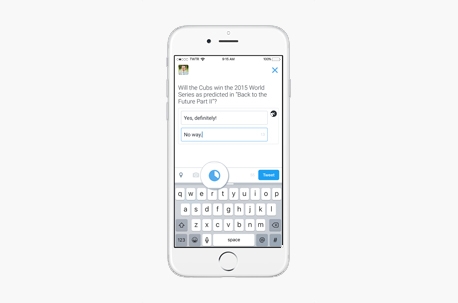Twitter has recently launched its Twitter Polls feature, which enables users to tap into this vast reservoir. At Clicked we were keen to investigate what this might mean for researchers and how we might be able to make good use of them.
Twitter makes it easy
First of all they are really easy to use. Compose a new tweet and at the bottom is the option to create a “Poll”. When we started experimenting with the polling feature there were just two response options, but Twitter soon increased that to a possible four.
Create your question and up to four possible responses within a 116 character limit, tweet the poll, and watch the response. It is literally that easy to set up! The poll stays open for 24 hours; the voters remain anonymous and only once they have voted do they see how the results look.
You can either run the poll for free to your own followers and those to whom they re-tweet (organic), or pay for the poll to be promoted. When promoted, the poll will go out to anyone – Twitter will promote the tweet in users’ timelines in a random way. This broadens the reach making it both more representative than your followers and means that you’ll end up with more responses.
Clicked has a modest 320 followers so we found it necessary to promote all of our polls in a random way. The more you spend, the more responses are gathered. We spent the same amount to promote each poll and gathered between 97 and 184 votes. It’s worthwhile noting that using the advanced features, Twitter provides the opportunity to target users based on geodemographics, device usage, interests and behaviours in a fairly sophisticated way – almost approaching the sophistication of a panel.
To generate a rounded view of twitter polls, we created five polls on the following subjects:
- The perceived novelty factor of smart watches
- Banning Russia from the Olympics
- Over the top video consumption
- Data privacy
- Black Friday spending
What are the limitations?
Here are eight things you need to keep in mind when designing your own polls.
- Sample size – we found that around 10% of votes will be organic – from your followers or from re-tweets. This means accounts with a large following may not need to promote tweets. A level of about 10% response is common at the moment but it could still be a function of the novelty of Twitter polls. We expect this to decline over time.
- Keep to topics on which people are going to have a view or care. We noted a poll about the appeal of Justin Bieber v One Direction from a heavily followed account that received just 19 votes. It suggests that many couldn’t care less and may vote cynically.
- Respondent profile – there are limitations as to how you can analyse the data. While you can target users in a fairly sophisticated way, it’s not possible to profile users by how they vote – Twitter can only offer analysis of engagements.
- Consider the timing of the poll. Most responses are achieved in the first few hours after launch – typically the first four hours. The peak time for response we found to be 8-9 pm.
- Character limit – you are limited to 116 characters and so the question has to be framed precisely and carefully.
- You are limited to four answer, single choice options – although restrictive, this can be positive.
- 24hrs – voting closing within 24hrs can in fact be quite a limitation.
- Representativeness – we are a research agency specialising in digital and using Twitter for polls suits us perfectly as we are keen to determine the views of those who are technology-aware. However, it certainly isn’t the right vehicle to reach every audience.
What is it good for?
Essentially anything that can be contained within the 116 character limit and up to four answer options. At the time of writing it is not possible to include pictures or videos directly but you can include links. That gives you the option to show material to people and ask them to make choices.
Some ideas of how Twitter Polls could be used include: refining hypotheses, getting predictions, gauging reactions to trending news topics, generating brand buzz (by asking questions that are likely to be retweeted), determining behaviour (e.g. consumption of content) and how it changes throughout the day, driving traffic to websites to vote on design, investigating reactions to live events, and helping with brand direction.
To sum up
The spirit of Twitter is that it consists of bitesize pieces of information that are topical and informative. Our view is that the polls should be so – this isn’t a place for serious survey questions, at least for now. It is fun and a very low-cost and fast way of getting information.
They may be fun, but there are indications they are also very effective. While they have limitations and are not a mechanism for every topic and audience, we’ve seen how the results of a poll on smart watches compare well to our wearables tracking study that polls 1,000 nationally representative people.
Finally, keep in mind that voters on Twitter are voting because the tweet has caught their interest, not because they are receiving a financial incentive. This emotional investment in the vote suggests the results can be trusted to be a robust representation of the true picture of a topic.
Neil Russell is quantitative director at Clicked








0 Comments